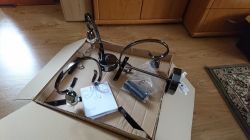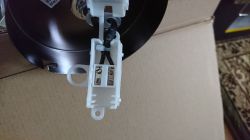FAQ
TL;DR: Most 2‑wire chandeliers can’t split bulbs; you need 3 conductors for two‑button control. “If two cables come out… not possible.” [Elektroda, zdzicho1233, post #17026776]
Why it matters: This helps DIYers and renters wire a 3‑lamp chandelier to a 2‑gang switch safely and correctly.
Quick Facts
- Two‑gang control needs a three‑wire fixture layout: common neutral plus two switched lives. [Elektroda, zdzicho1233, post #17026776]
- Ceiling conductors often present: blue (neutral), black/brown (switched lives), green‑yellow (protective earth). [Elektroda, krzysiozak, post #17026862]
- Connect protective earth to the metal body only when the luminaire is Class I. [Elektroda, zbich70, post #17028438]
- A 3‑lamp, 2+1 setup gives four states: off, one on, two on, or all three. [Elektroda, krzysiozak, post #17026796]
- Some store models come factory‑wired 2+1; confirm before buying or exchange if needed. [Elektroda, jac0205, post #17030838]
Can I control 1 bulb with button A and 2 bulbs with button B if the chandelier has only two input wires?
No. Two input wires mean one circuit for all lamps. Separate control requires a third conductor inside the fixture: shared neutral and two switched lives. A dimmer can vary brightness of all bulbs together, but not split them. An electrician can rewire the chandelier internally to three‑wire. “Convert the installation in the chandelier into three‑wire.” [Elektroda, zdzicho1233, post #17026776]
How do I connect all bulbs to work together from a two‑button switch?
Use one switched live and neutral; insulate the unused live. Connect protective earth to the metal body if applicable.
- Isolate power at the breaker and verify it is off.
- Connect ceiling blue (neutral) to the lamp’s N terminal.
- Connect either black or brown (a switched live) to the lamp’s L; cap the other switched live safely. [Elektroda, krzysiozak, post #17026862]
What do the blue, black, brown, and green‑yellow wires in the ceiling do?
Blue is neutral. Black and brown are the two switch returns (switched lives) from a two‑gang switch. Green‑yellow is protective earth, which should bond to the luminaire’s metal body when required. Use one switched live plus neutral for a single‑circuit lamp. Insulate the unused switched live if not used. [Elektroda, krzysiozak, post #17026862]
Where should the green‑yellow wire go on a metal chandelier?
Terminate the green‑yellow protective earth to the chandelier’s earthing point when the luminaire is protection Class I. This bonds exposed metal parts to earth, improving safety in a fault. Do not omit this connection on Class I fixtures. It is part of basic safety practice for metal luminaires. [Elektroda, zbich70, post #17028438]
What if my chandelier is Class II (double‑insulated)? Do I connect earth?
No. Class II luminaires do not require a protective earth connection. They have reinforced or double insulation and typically provide no earth terminal. Do not attempt to add an earth to a Class II lamp. That is an incorrect modification and can create hazards. Connect only the live(s) and neutral as intended. [Elektroda, zbich70, post #17028438]
What does “2+1” wiring on a chandelier mean?
It means the fixture accepts two separate live inputs feeding two lamp groups while sharing one common neutral. A common arrangement with three lamps is 1+2. Each button on a two‑gang switch controls one group. An electrician can also convert many multi‑lamp fixtures to this internal split. [Elektroda, cirrostrato, post #17026825]
I bought a two‑wire fixture but want split control. Should I return or modify it?
Exchange it for a model supporting two circuits if possible. Avoid makeshift conversions. Internal rewiring should be done properly and safely by a qualified electrician. Returning is often faster and cleaner than custom modification, especially for new retail fixtures. [Elektroda, krzysiozak, post #17026841]
Can I use a dimmer instead of rewiring for split control?
A dimmer can adjust brightness of all bulbs together on a two‑wire chandelier. It will not provide separate on/off control of different bulb groups. Choose a dimmer compatible with your lamp type as specified by the manufacturer. [Elektroda, zdzicho1233, post #17026776]
How many lighting combinations do I get with a 3‑lamp, 2+1 setup?
You get four states: none, one lamp on, two lamps on, or all three on. This 4‑state flexibility is why many users prefer 2+1 wiring with a two‑gang wall switch. “You probably want 1, 2 or 3 light sources to shine. Or none.” [Elektroda, krzysiozak, post #17026796]
How can I check which ceiling wire is the phase with basic tools?
A neon test screwdriver can indicate the presence of phase on a conductor. A simple circuit tester or meter is more informative, but even a neon tester helps identify the live before you connect. Always confirm power is isolated before making any connections. [Elektroda, krzysiozak, post #17026780]
Which switched conductor should I use, black or brown?
Either black or brown can be used as the switched live to the lamp. They are separate returns from the two‑gang switch. Connect one to L and insulate the other safely if unused. Ensure neutral goes to N and earth bonds appropriately. [Elektroda, krzysiozak, post #17026862]
Is this wiring safe for a layperson to attempt?
If you are a layperson, hire a qualified electrician. “Get the job done by a professional electrician.” This avoids wiring errors, ensures compliance, and protects warranty and insurance. Safety and correct classification (Class I vs II) must be respected. [Elektroda, krzysiozak, post #17026767]
My chandelier is metal but has only two input wires—what does that imply?
Metal fixtures typically provide a yellow‑green earth connection when they are Class I. If no earth input is provided, do not improvise one. Verify the protection class on the rating label and consult a professional or exchange the fixture if needed. [Elektroda, krzysiozak, post #17026811]
My lamp is factory‑wired 2+1. How do I connect it to a 4‑wire ceiling?
Connect the lamp’s common N to the ceiling blue neutral. Connect the two live inputs (often marked L1 and L2) to the two switched returns from the wall switch (black and brown). Bond protective earth to the body if the lamp is Class I. [Elektroda, zdzicho1233, post #17026776]




